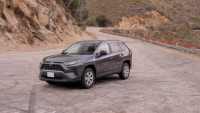The RAV4 is one of the most popular models in Toyota's line of SUVs. The first version rolled off the assembly line in 1994. In 2015, a hybrid version appeared. Over the years, the RAV4 has changed the design a little, acquired perfect technical data, while maintaining the new Asian spirit. And in 2019 came the new Toyota RAV 4 hybrid.
The exterior of the 2019 Toyota Rav 4 Hybrid The 2019 Toyota Rav 4 Hybrid combines the compact dimensions and exterior image of an SUV. The front of the car is equipped with a massive bumper with a large radiator grille, as well as LED spotlighting.
The 2019 Toyota Rav 4 Hybrid combines the compact dimensions and exterior image of an SUV. The front of the car is equipped with a massive bumper with a large radiator grille, as well as LED spotlighting.
The rear of the SUV has co-designed LED lights, large luggage door, spoiler, and dual exhaust tips.
On the sides of the body has square wheel arches with plastic linings, as well as 18-inch wheels.
The 2019 Toyota Rav 4 Hybrid has the following body dimensions: length-4.6 m, width-1.855 m, height-1.685 m.
Interior of the 2019 Toyota RAV 4 Hybrid The interior of the 2019 Toyota RAV4 Hybrid is made of quality materials and is comfortable and functional.
The interior of the 2019 Toyota RAV4 Hybrid is made of quality materials and is comfortable and functional.
The instrument panel has a wide 4.2 inch display, which displays the information needed by the driver. In the center there is a 7-inch screen of my multimedia system, with 3D viewing mode, Apple CarPlay support. And there is a digital interior mirror, which shows the image of the rearview camera when you switch it.
In front of the control unit there are 12V and AUX ports, as well as a USB port. The package includes a JBL 9-speaker sound system.
There are two rows of comfortable seats in the cabin. The first row has comfortable seats with advanced side support and 3-step ventilation. The back row is very spacious, with ventilation deflectors, adjustable backrest tilt and heating. The luggage compartment has a capacity of 1,064 liters.
A view of the hybrid unit
The basis for the design of the SUV was the TNGA platform (translated as "New Toyota Global Architecture"), the main feature is the low location of the power plant.
The power plant of the SUV consists of an internal combustion engine and a THS II with ECVT. There is also an additional electric motor on the rear axle, a battery and an electronic variator.
The hybrid engine works as follows: the engine with the traction motor works in front, which is connected to the stepless transmission, and at the rear there is a separate electric motor. During acceleration, all engines are used.
The THS II allows the engine to remain at its most efficient rpm, using the electric motor-generator to continuously change the transmission ratio for smooth acceleration. In combination with electric powertrain combinations, it creates an optimal way to get more power with less fuel. The power output is 222 hp.
Gasoline engine.
The Toyota RAV4 Hybrid 2019 is powered by a 2.5-liter A25A-FXS series Dynamic Force four-cylinder gasoline engine. The engine runs according to the Atkinson cycle with D-4S fuel injection. Electronic inlet/outlet cam timing adjustment is used, compression ratio is 14:1.
The power of the petrol unit is 178 hp at 5700 rpm. Max torque is 221 Nm.
Electric motor
The 2019 RAV4 Hybrid uses electric motors along with the internal combustion engine. The first 3NM is responsible for the front axle and has a power of 88 kW.
The full drive version also has a rear 4NM motor (to operate the rear axle, it takes part in the regeneration process) with a power of 40 kW. It is connected to the hybrid system's main components using a separate gearbox. The maximum torque at the rear wheels can be up to 1300 Nm.
Battery and mileage
The new 2019 Rav 4 is equipped with a me-tallohydraulic battery pack. Thanks to improvements in the components, the battery is smaller and lighter (by 11%). The tractive power control unit has also been reduced.
The nominal voltage for the battery pack is 245 volts (the maximum voltage of the plant can reach 650 volts). The battery capacity is 6.5 A*h. It is not possible to drive for a long time on electric power. Maximum is 2 km, at speeds up to 55 km/h. If there is not enough charge, the internal combustion engine will start.
Fuel consumption per 100 km and dynamics
The Japanese have managed to adapt the car well to the road conditions, showing at the same time decent dynamics. Acceleration to a "hundred" takes 8,1 seconds. At the same time, the top speed is 180 km/h. For a car of this class it is quite normal.
The efficiency of the Rav 4 is also at a level. When driving on the highway will spend from 4.7 to 5.7 liters of fuel, depending on the speed. In the city the figure will increase to 6 liters. In the car's cycle the fuel consumption is 4.4 liters per 100 km.
Hybrid reliability
In the new Toyota RAV4 hybrid, a lot of attention is paid to reliability and safety.
From the advantages of the car, we can highlight: good elegance, quality interior materials, eco-nomic performance, smooth operation of the suspension and suspension, which feels confident even on rough roads.
The disadvantages are the lack of support for Android Auto and backlighting of some buttons and doors, as well as the lack of opening of the luggage compartment door and poor sound insulation.
Operation in winter
No problems occur while using the car in winter. The engine starts right away. The manual even says that warming up is not necessary at all. To avoid unnecessary loading, in severe cold it is better to warm up the car for 2-3 minutes.
The battery in cold weather works in a standard mode, without losing power. The interior warms up quickly. Heat from the heater comes as soon as the hybrid system is activated. Additionally, the seats, steering wheel and rear window are heated.
Who is the Toyota RAV 4 Hybrid for?
The developers of the new 2019 Toyota RAV4 Hybrid tried to change the exterior of the car and to attract the attention of the audience. But the spacious interior, multifunctionality and safety will also attract the attention of people with families. With this car you can easily overcome easy obstacles on the road and take your luggage for an exciting journey.
Conclusion
Toyota RAV4 Hybrid 2019 is a worthy continuer of the hybrid line based on the RAV 4. The exterior has been redesigned, eliminating many shortcomings. In technical terms, progress is also visible. The car became more quick and pleasant to drive.




